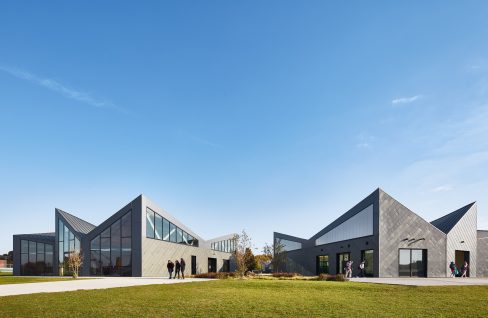The Plan — “Architecture Drives Change”
June 2018
“Studio Gang has been thinking about the Chicago River for some time. In 2011, Jeanne Gang taught a studio at the Harvard Graduate School of Design … a theoretical endeavor that led to a publication titled Reverse Effect: Renewing Chicago’s Waterways. That Harvard studio proposed designs for a hydrological barrier and center for limnology at the curiously named Bubbly Creek. The publication catalogs the student work but also lays out the history of Chicago’s multi-pronged river and many critical environmental issues facing waterways linking Lake Michigan and the Great Lakes to the Des Plaines River, just west of Chicago. …
The Eleanor Boathouse by Studio Gang is both a tectonic exercise, i.e. a formal object, and an expression or outcome of the recuperation of Chicago’s complex hydrological network. …
The boathouse both signals the geometry of exercise through its morphology and helps revitalize the river as a public amenity—the ‘backyard of the city,’ in Gang’s words, to complement the magnificent ‘front yard’ of Lake Michigan … It is intended as a meeting place for groups across society: teenagers from local high schools, young adults from the University of Chicago and the Illinois Institute of Technology, and, as on a recent cold winter morning, cancer survivors embracing exercise as therapy. …
The manipulation by Gang of comparatively simple steel trusses give the boathouse its jaunty zigzag or sawtooth roof, its key identifying element. The trusses alternate between ‘A’ and ‘M’ configurations, the former rising to a peak at midpoint, the latter sloping from a low midpoint to an apex at both extremities. Gang admires the resulting syncopation, [likening] the succession of high and low members to the movement and rhythm of rowers out on the water, a neat metaphor for the project and one heralding the specificity of its purpose. Fifty years ago, Robert Venturi proposed a classification of buildings as either duck or decorated shed. Gang’s boathouse is slyly, and economically, in between such categories. Her pavilions harness their modest components to meaningful effect, exploiting the spare physicality of the trusses to lift the architecture from two to three dimensions, from flatness to spatiality, and creating a facility with urban and topographic resonance.
Gang is adept at introducing small inflections into building components and their assembly, an approach to morphology with affinities to fabric design yet also, at a larger scale, recalling form and pattern found in nature. An architecture, therefore, less static ans self-referential than Venturi’s shed and more responsive to exterior phenomena of topography, climate, and infrastructure. In her Reverse Effect publication, Gang envisaged ‘the city as an interconnected, ecological system … from humans all the way down the food chain to algae.’ At [the boathouse], and in other recent works … Gang is working toward a new environmental balance in the Windy City, a constructed and deliberate equilibrium in which even a desolate and abandoned river can work afresh for society’s benefit and pleasure.”

